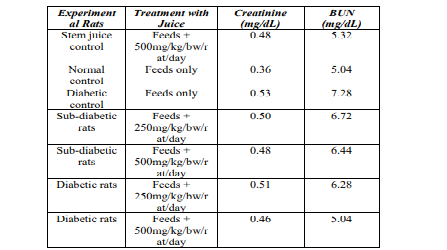Evaluation of Renoprotective Potential of Plantain (Musa parasidiaca) Stem Juice on Rat Model Diabetes
Keywords:
Diabetes, BUN, Creatinine, Alloxan, Musa parasidiacaAbstract
The prevalence of diabetes mellitus in the world is increasing. Hyperglycemia in diabetes mellitus can increase the risk of complications in various organs, one of which is chronic renal failure because symptoms of type 2 diabetes, unlike type 1 diabetes, do not occur, the screening methods for identifying kidney involvement is very important. In chronic renal failure, a decline in kidney function is chronic, resulting in increase of the levels of blood urea nitrogen (BUN) and creatinine in the blood. A level of BUN and creatinine serum is use as a parameter of kidney function tests. Plant-derived medicinal products have attracted the attention of scientists around the world for many years due to their minimum side effects and positive effects on human health hence the choice of plant used in the present study. 35 healthy Albino (Wister strain) were obtained and grouped into seven. The results obtained from sub-diabetic and diabetic rats both treated with 250mg/kg/bw and 500mg/kg/bw respectively when compared with diabetic control, plantain stem juice shows a lowering effect on the blood creatinine and BUN concentration. The effect of the stem juice of Musa paradisiaca suggests that it can be useful in controlling creatinine and BUN concentration in diabetics and will serve as a better alternative to synthetic drugs.
References
K.P. Kumar, D. Bhowmi, S. Duraivel, M. Umadevi, "Traditional and Medicinal Uses of Banana", Journal of Oncol. Pharm. Pract, Vol.1, pp.51-63, 2012.
S. Puspitasari, A. Andika, "Relationship Between Renal Function Test Serum and Lipid Profile in Patient with Diabetes Mellitus", Journal of Physics, Vol.1114, Issue.1, pp.1-2, 2018.
D.S.S. Barbosa, I.B. Sarmento, T.C.L. Bargut, V. Souza-mello, M.B. Aquila, D.C.A. Mandarim, "Animal Model of Nutritional Induction of Type 2 Diabetes Mellitus", International Journal of Morphology, Vol.32, Issue.1, pp.279-280, 2014.
M.A. Mya, T.A. Hnin, M.S. Myint, A.Chabaco, "A Review on the Phytochemistry, Medicinal Properties and Pharmacological Activities of 115 Selected Myanmar Medicinal Plants" Molecules, Vol.24, pp.293-294, 2019.
P. Singh, "Green Synthesis and Characterization of Silver Nanoparticles by Using Aloe Vera Plant Extract", International Journal of Scientific Research in Chemical Sciences, Vol.6, Issue.3, pp.1-3, 2019.
E.A. Palombo, "Phytochemicals from Traditional Medicinal Plants Used in the Treatment of Diarrhoea: Modes of Actions and Effects on Intestinal Function", Phytotherapy Research, Vol.20, pp.717-724, 2005.
S.M. Jachak, A. Saklani, "Challenges and Opportunities in Drug Discovery from Plants". Current Science, Vol.92, Issue.9, pp.1251-1257, 2007.
Z. I. Mohammad, A. Saleha, "Musa paradisiaca L. and Musa sapientum L.: A Phytochemical and Pharmacological Review". Journal of Applied Pharmaceutical Sciences, Vol.1, Issue.5, pp.14-20, 2011.
S.K. Singh, A.N. Kesari, P.K. Rai, G. Watal, "Assessment of Glycemic Potential of Musa paradisiaca Stem Juice", Indian Journal of Clinical Biochemistry, Vol.22, Issue.2, pp.48-52, 2007.
A., Aminu, A. K., Maigari, I. H., Hamza, I. C., Asongo, K. I., Nadada, "Sustainable Use of Plant Products in Ethnomedicine as a Promising Panacea to Effective Control of Trypanosomiasis: A Review", Journal of Scientific Research in Chemical Sciences, Vol.6, Issue.2, pp.13-17, 2019.
E. Benjamin, K. Ajibesin, O. Eseyin, B. Danladi, "Evaluation of Hypoglycemic Activities of Musa paradisiaca in Rats", International Journal of Research in Ayurrida and Pharmacy, Vol.2, Issue.2, pp.498-499, 2011.
N.S. Mathew, P.S. Negi, "Traditional Uses, Phytochemistry and Pharmacology of Wild Banana (Musa acuminata): A Review", Journal of Ethnopharmacology, Vol.1, pp.124-125, 2017.
A.R. De-Silva, C.D. Cerdeira, A.R. Brito, B.C.C. Salles, G.F. Ravazi, G.D.I. Moraes, L.R.A. Rufino, R.B.S. De-Oliveira, G.B. Santos, "Green Banana Pasta Diet Prevents Oxidative Damage in Liver and Kidney and Improves Biochemical Parameters in type 1 Diabetic Rats", Archives of Endocrinology Metabolism, Vol.60, pp.355-356, 2016.
O. Famakin, A. Fatoyinbo, O.S. ljarotimi, A.A. Badejo, T.N. Fagbemi, "Assessment of Nutritional Quality, Glycaemic Index, Antidiabetic and Sensory Properties of Plantain (Musa paradisiaca) Based Functional Dough Meals", Journal of Food Science and Technology Mysore, Vol.53, pp.65-66, 2016.
I.O. Ayoola, M.B. Gueye, M.A. Sonibare, M.T. Abberton, "Antioxidant Activity and Acetylcholinesterase Inhibition of Field and In-vitro Grown Musa L. Species", Journal of Food Measurement and Characterization, Vol.11, pp.488-499, 2017.
J.A. Ojewole, C.O. Adewunmi, "Hypoglycemie Effect of Methanolic Extract of Musa paradisiaca (Musaceae) Green Fruits in Normal and Diabetic Mice", Methods Find. Ern Clin. Pharmacol, Vol.25, Issue.6, p.453.
P.K. Rai, D. Jaiswal, N.K. Rai, S. Pandhija, A.K. Rai, G. Watal, "Role of Glycemic Elements of Cynodon Dactylon and Musa paradisiaca in Diabetes Management", Lasers Med. Sci. Vol.24, Issue.5, pp.761-768, 2009.
C. Mallick, R. Maiti, D. Ghosh, "Comparative Study on Antihyperglycemic and Antihyperlipidemic: Effects of Separate and Composite Extract of Seed of Eugenia Jambolana and Root of Musa paradisiaca in Streptozotocin-Induced Diabetic Male Albino Rat", Iranian Journal of Pharmacology Ther, Vol.5, Issue.1, pp.27-33, 2007.
L. Pari, U.J. Maheshwari, "Hypoglycemic Effect of Musa sapientum L. in Alloxan-induced Diabetic Rats", Journal of Ethnopharmacology, Vol.68, pp.321-235, 1999.

Downloads
Published
How to Cite
Issue
Section
License

This work is licensed under a Creative Commons Attribution 4.0 International License.
Authors contributing to this journal agree to publish their articles under the Creative Commons Attribution 4.0 International License, allowing third parties to share their work (copy, distribute, transmit) and to adapt it, under the condition that the authors are given credit and that in the event of reuse or distribution, the terms of this license are made clear.





